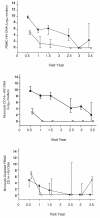Failure to clear intra-monocyte HIV infection linked to persistent neuropsychological testing impairment after first-line combined antiretroviral therapy
- PMID: 22207583
- PMCID: PMC3310342
- DOI: 10.1007/s13365-011-0068-8
Failure to clear intra-monocyte HIV infection linked to persistent neuropsychological testing impairment after first-line combined antiretroviral therapy
Abstract
HIV-associated neurocognitive disorders (HAND) persist despite plasma HIV RNA suppression with antiretrovirals (ARV). Sequestered reservoirs in the central nervous system and circulating monocytes are theorized to contribute to persistent brain injury. We previously demonstrated that elevated intracellular HIV DNA from circulating cells was associated with HAND in ARV-treated and ARV-naive subjects. We now report that failure to suppress intra-monocyte HIV DNA 3.5 years after initiating ARV is linked to persistent HAND and subjects with dementia are least likely to suppress intra-monocyte HIV DNA at 3.5 years. These findings suggest that antiviral strategies may need to target intra-monocyte HIV DNA.
Figures

References
-
- Anekthananon T, Ratanasuwan W, Techasathit W, Sonjai A, Suwanagool S. Safety and efficacy of a simplified fixed-dose combination of stavudine, lamivudine and nevirapine (GPO-VIR) for the treatment of advanced HIV-infected patients: a 24-week study. J Med Assos Thail Suppl. 2004;87:760–767. - PubMed
-
- Clifford DB. HIV-associated neurocognitive disease continues in the antiretroviral era. Top HIV Med. 2008;16:94–98. - PubMed
-
- Denning DW. The neurological features of acute HIV infection. Biomed Pharmacother. 1988;42:11–14. - PubMed
-
- Ellery PJ, Tippett E, Chiu YL, Paukovics G, Cameron PU, Solomon A, Lewin SR, Gorry PR, Jaworowski A, Greene WC, Sonza S, Crowe SM. The CD16+ monocyte subset is more permissive to infection and preferentially harbors HIV-1 in vivo. J Immunol. 2007;178:6581–6589. - PubMed
Publication types
MeSH terms
Substances
Grants and funding
LinkOut - more resources
Full Text Sources
Medical

